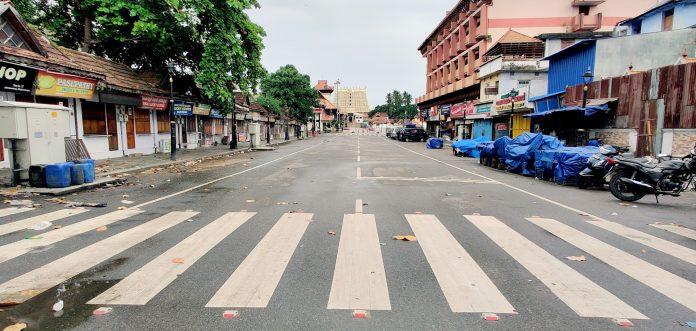COVID-19: Kerala Gears up to Nip in the Bud the Threat of Community Transmission

Image Courtesy: The Print
Kerala's COIVD-19 tally on Tuesday touched 5,894 with 272 fresh cases reported. Out of these, 157 are from among the abroad returnees, 38 from other states, and the rest, 68, have been infected through contact. Origin of infection for 15 of the 68 cases could not be traced, said Chief Minister Pinarayi Vijayan.
On Monday, 193 people had tested positive. Among these, 92 patients had come from abroad, 62 from other states, while 35 have been infected through contact.
The increase in the number of positive cases through contact is becoming a serious concern for the state administration and health officials. On Monday evening, Chief Minister Pinarayi Vijayan said that community spread was a threat and the government was taking various steps to prevent it, including the triple lockdown and widespread testing.
On July 5, 38 patients had reportedly contracted the disease through contact; on July 4, the number was 17. On July 3, of the total 211 new cases, 27 were infected through contact.
Source: Chief Minister's daily press conferences.
On Sunday, Thiruvananthapuram district had the most number of cases through contact at 22, forcing the administration to strengthen the implementation of the health protocol. The state government has imposed a triple lockdown for a week in Thiruvananthapuram corporation limits from Monday morning owing to which all the government offices, private establishments are shut and public transport is off the roads.
On January 30, India’s first COVID-19 case was reported from Kerala when a medical student who had returned from Wuhan in China had tested positive. The state government, however, had started passenger screening at airports from December itself.
Kerala’s public healthcare system has stood out for having dealt with the pandemic effectively so far and Health Minister KK Shailaja, along with the Left Front government in the state, has garnered appreciation internationally for the ‘Kerala model’.
Kerala had recorded only three deaths early in May. But, by this time, Italy, the European country which had recorded its first case around the same time as Kerala, had recorded deaths of over 30,000 people. The case fatality rate over there was 14.4%. By May 3, no new cases were being reported in Kerala with only 95 active cases.
However, two months later, by July 3, the total number of positive cases in the state had climbed up to 4,465, which is nearly nine times the tally of May 3. On July 6, it increased to eleven-fold with the total number of cases standing at 5,622. How did this happen?
When the Centre announced the first lockdown from March 25 to curb the further spread of the virus, many Keralites were stuck in various parts of the country and also in other countries. They could not return home amid the pandemic as the flight services had been suspended. However, with the launch of Vande Bharat Mission by the Centre, the process of repatriation was kicked off. The first flights to Kerala arrived on May 7, together carrying 363 passengers [one flight each had landed in Kochi and Kozhikode from Abu Dhabi and Dubai, UAE].
Then on May 8, two flights landed at the Kozhikode and Kochi airports carrying 325 passengers from Saudi Arabia’s Riyadh and Bahrain’s Manama. On May 9, three flights carrying 545 passengers had landed at the Kochi airport from Kuwait, Muscat in Oman, and Doha in Qatar. On May 10, Indian Navy’s INS Jalashwa, under the mission Operation Samudra Setu, reached Kochi port with 698 Indians from Maldives on board. An Air India flight with 177 passengers also landed in Kochi, coming from Kuala Lumpur.
In the coming days, more and more flights landed in the state, most of which were from the Gulf Cooperation Council (GCC) countries. Meanwhile, the first passenger train departed from New Delhi carrying stranded Keralites and it reached Thiruvananthapuram on May 15. Many other special trains followed.
With these arrivals, from May 13, Kerala started reporting two-digit numbers of cases. There were 26 new cases on May 14.
As the checkposts were also opened in May, many were coming back by road as well.
On June 5, Kerala recorded 111 fresh cases when for the first time the number was three-digit for a single day. On June 6, there were 108 fresh cases.
Since the imposition of the nationwide lockdown, 4,99,529 people have returned to Kerala. Of these, 1,85,435 have returned from abroad and the rest are from other Indian states.
As on July 7, the number of active cases in the state stood at 2,413. Till July 6, 2,04,452 samples have been sent for testing.
On Monday, Chief Minister Vijayan said that testing will be intensified in the border areas, especially in Manjeswaram of Kasaragod district from where people commute to Mangalore in Karnataka on a daily basis.
This is also causing the spread of the virus, he said, adding that daily travel in this manner cannot be allowed.
(With inputs from PTI)
Also read: COVID-19: People in Kashmir Flout Distancing Guidelines Despite Increasing Cases
Get the latest reports & analysis with people's perspective on Protests, movements & deep analytical videos, discussions of the current affairs in your Telegram app. Subscribe to NewsClick's Telegram channel & get Real-Time updates on stories, as they get published on our website.
























